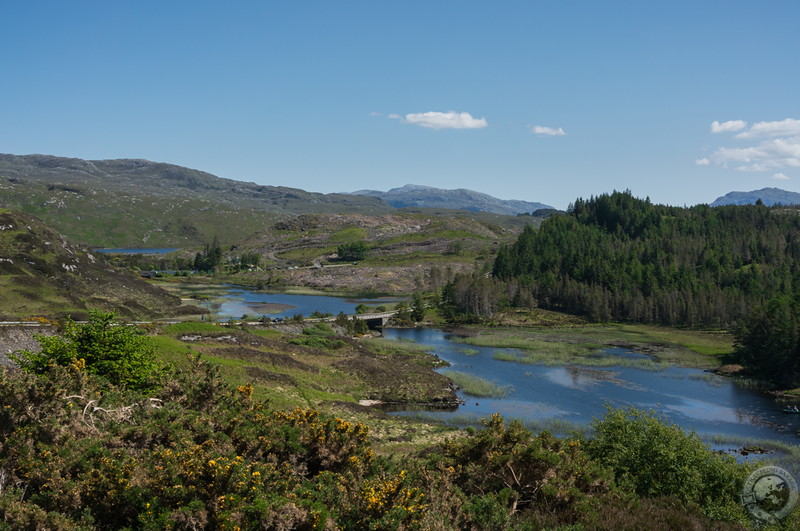Take a look at the northern horn of Scotland and most of what you see is the region called Sutherland. From just north of Ullapool all the way up to Cape Wrath and Durness, Sutherland then swoops east almost to Thurso and south to Dornoch to include places like Clynelish Distillery and Dunrobin Castle on the east coast. Only the northeastern corner, an area called Caithness, is saved from Sutherland’s sweep, and I’ll cover that region next week. This is a truly large section of the highlands, and the irony is that much of it is inaccessible (more on this below). Today, Sutherland is a sparsely populated corner of Scotland thanks, largely, to the Highland Clearances of the 18th and 19th centuries, which hit the crofting communities here extremely hard.
An unintended side effect of the Clearances — and if there is a silver lining to that reprehensible act this is it — is that Sutherland, especially the western and northern parts, have retained an older, wilder appearance. Infrastructure throughout the area is minimal, towns are tiny, often little more than a handful of buildings, and the wildlife is plentiful. This is a place to get lost in, both figuratively and literally. Sutherland feels a bit like a wild animal, wary of visitors and unsure when to bolt from your presence, but a curious beauty to look upon.
Impressions
This is true wilderness. I hinted at this above. Most of Sutherland can only be traversed by single-track coastal roads in the west and north and by the comparatively speedy A9 on the east coast. The interior is mostly off limits. There are a few roads that run south through glens that provide a rustic means of traveling across this hilly, loch-slashed interior, but some of of these roads are in pretty rough shape and you might not pass a soul on them (pray you don’t have car trouble). This is the first place on my travels where the land overpowers the car, and, as such, makes the ideal region for experienced backpackers to ramble and camp. I wish I was that person. It would be amazing to load up a pack and cross the hills and moors, find some truly elite views, and get a feeling for what Scotland must have been like long ago. This might be one of the last places in Europe to take such an adventure.
Incredible beaches abound. When most people think of northern Scotland they don’t think of beaches. From Achmelvich and Oldshoremore and Sandwood Bay to Rispond and Balnakeil Bay and Sangobeg Sands, amazing beaches are everywhere. These are beaches of the finest red and white sand. Beaches reaching into clear, turquoise water. Beaches empty but for the wind and the waves. Beaches that would put many of the best Caribbean and Mediterranean beaches to shame. You will find them all along the west and north coasts of Sutherland, and when you brace yourself against the chill wind and stick your toes in the bone-numbingly cold water you will understand. And yet, the frigid elements do nothing to detract from the beauty of these places.
Travel is slow and wonderful. I thought the roads in Wester Ross were interesting. In Sutherland, many of the main roads are single-track roads. There’s also the Wee Mad Road of Sutherland, but that’s for a future post. Speed is not your friend here. Even if you could approach 6omph, as Google Maps seems to think you can, you would miss so much beauty. The reality is that winding, slow roads require you to be attentive — for oncoming traffic and wildlife — and this also makes you appreciate the area’s wild grandeur. This is true mostly for western and parts of northern Sutherland. As you venture further east toward Caithness two-lane roads return and the land levels out and becomes less interesting. The east coast of Sutherland, with the speedy A9, is an entirely different animal, and the hairpin turns around the Berriedale Braes will be laughable after what you’ve traversed in the west.
There are secrets waiting to be found. This impression goes hand in hand with the note about Sutherland being a wilderness. Because there are so few roads and so much open land, there must be secrets waiting for the intrepid traveler. Perhaps it’s not a secret, but the Dun Dornigail Broch south of Loch Hope is just the type of thing I’m talking about. People lived in these vales thousands of years ago and nobody lives there today. What else is out there?
I’ll be back next week with my final impressions from the road. In the meantime, check out Facebook, Twitter, and Instagram for extra photos, updates, and thoughts from my recent trip around the North Coast 500!


I just love the wild north and west of Scotland. The scenery is magnificent and I love the feeling of almost complete isolation that you can get when you drive for miles and see absolutely no one – maybe the postman but that’s it!
I also get the feeling we have a similar eye when it comes to photos – here’s one from our 2012 trip.
https://www.flickr.com/photos/jlstuht/7472097048/in/album-72157630354985774/
Jim S
Too bad the water isn’t warmer, though if they were, this place would be overflowing with punters. Probably best that it isn’t. Great post!
[…] you’ve had a chance to read my impressions from the road about Wester Ross, Sutherland, and Caithness. Those posts collected my thoughts on each area while I was on the road. Today’s […]